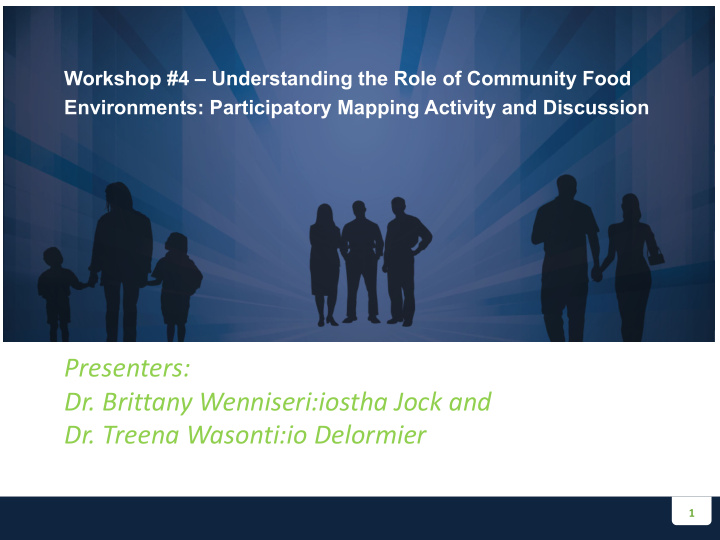



Workshop #4 – Understanding the Role of Community Food Environments: Participatory Mapping Activity and Discussion Presenters: Dr. Brittany Wenniseri:iostha Jock and Dr. Treena Wasonti:io Delormier 1
Background • Three different types of determinants of food choices : - Food-related (biological predispositions and experiences); - Individual (personal determinants); - Environmental (physical, sociocultural, economic, political). NUT-U001 2 Certification universitaire en nutrition en santé publique
Environmental determinants of food choice • This figure identifies the individual-level determinants and environmental-level determinants , as defined as part of the Common view of supportive environments : Environment-related determinants Personal determinants Physical environment • Natural • Artificial (built and designed) Experience with food • Artificial (technological) Associative conditioning Internal factors Sociocultural environment Physiological • Perceptions • Social relations conditioning • Attitudes Biologically determined • Norms and conventions • Beliefs • Familiarity: behavioral predispositions • Vision and representation of programmed safety • Motivations reality • Taste/pleasure • Conditioned and values Political environment • Sweet, sour, salty and bitter food preferences • Personal • System and political culture • Hunger/satiety mechanisms • Conditioned satiety meaning • Public policies, laws and • Sensory-specific satiety Social conditioning • Knowledge regulations • Socio-affective context and skills • Systems • Parenting practices • Social norms • Law and international treaties • Cultural norms Economic environment External factors • Price of goods and services • Family and Income and wealth distribution • social network • Business practices Figure adapted • Labor market • Institutions from: • Structure and economic Contento IR, 2011 situation et MSSS, Vision commune des environnements Food choices and eating Likes/dislikes Beliefs, attitudes, norms, Environmental influences favorables, 2012. behaviors Sensory-affective factors knowledge and skills NUT-U001 3 Certification universitaire en nutrition en santé publique
Four aspects of the structural environment • 1. Availability/accessibility • 2. Physical structures/characteristics • 3. Social structures and policies • 4. Media and cultural messages Cohen DA, Scribner RA, Farley TA, 2000 NUT-U001 4 Certification universitaire en nutrition en santé publique
1. Availability/accessibility • Relative access to healthy items vs. unhealthy items – Greater accessibility associated with increased purchase and consumption • Examples? Cohen DA, Scribner RA, Farley TA, 2000 NUT-U001 5 Certification universitaire en nutrition en santé publique
2. Physical structures/characteristics • Physical features of buildings/neighborhoods/places that influence behaviors • Examples? Cohen DA, Scribner RA, Farley TA, 2000 NUT-U001 6 Certification universitaire en nutrition en santé publique
3. Social structures and policies • Informal or informal policies that influence behaviors – Formal: capital “P” policies – written, developed by governing body/administration – Informal: little “p” policies – developed and enforced through norms • Examples? Cohen DA, Scribner RA, Farley TA, 2000 NUT-U001 7 Certification universitaire en nutrition en santé publique
4. Media and cultural messages • Messages that are frequently heard through various media outlets and through cultural practices. • Youth are more vulnerable to these messages • Examples? Cohen DA, Scribner RA, Farley TA, 2000 NUT-U001 8 Certification universitaire en nutrition en santé publique
Are we always aware of our food choices? • Although individuals’ food choices are sometimes intentional (e.g., reading food labels), they may be unintentional (e.g., food packaging). • They maybe be second nature – engrained practices. Children eat first, men get larger portions, always offer seconds. • Individuals’ automatic responses with regard to food stimuli thus have a significant impact on our behaviors. Nudging. NUT-U001 9 Certification universitaire en nutrition en santé publique
Examples using images... Intentional choice Automatic choice Image source: Image source: http://www.ukgraphicsdesigners.com/food- http://www.0530laval.com/espace_5/bien_lire_les_etique packaging/ ttes_des_aliments.html Assessment, planning... Emotions, impulsiveness...
Individuals’ automatic responses to food stimuli • Some exposure to food stimuli brings about ‘automatic responses’ that are absent of conscious cognitive process. – For instance, about a third of our calories are eaten outside the home. Foods eaten outside are more likely to be high in calories and fat, and low in nutritional value. These food choices may be in part due to the low availability of foods with a high nutritional value or due to the fact that such decisions (e.g., in restaurants) are likely to be spontaneous, fast and influenced by food stimuli. • Implications for interventions emphasizing education Cohen, D.A, et Babey S.H., 2012 In short, food choices and eating behaviors are influenced by a set of determinants related to food, individuals and the environment. Behaviors aren't always conscious and can be greatly influenced by the environment. In such a context, how is it possible to successfully promote changes health outcomes of individuals and the population? NUT-U001 11 Certification universitaire en nutrition en santé publique
Public Health “Structural interventions refer to public health interventions that promote health by altering the structural context within which health is produced and reproduced.” Blankenship K.M., et al, 2006 Framing health problems “as a product of and response to unjust conditions and environments, rather than as a disease rooted solely in individual pathology and responsibility” Mitchell, 2012 NUT-U001 12 Certification universitaire en nutrition en santé publique
Public Health Intervention • Assume that: – context of behaviors is important – Individual choices are constrained by context/environment Blankenship K.M., et al, 2006 NUT-U001 13 Certification universitaire en nutrition en santé publique
Mapping activity • Please get in groups of 3-4 people. Each group will get a posterboard and marker set • Thinking about where you live, work, hang with family: – what influences your food choices in your community? • Brainstorm and draw a conceptual map of these influences. NUT-U001 14 Certification universitaire en nutrition en santé publique
Recommend
More recommend